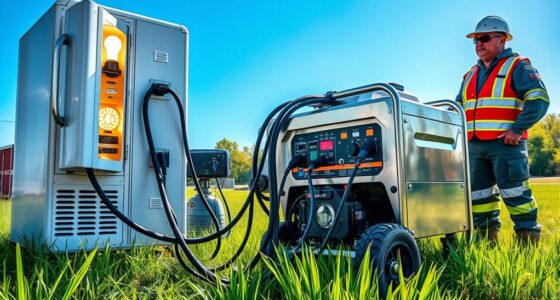To pack a family “lights-out” go kit, gather essential supplies like water, non-perishable food, and hygiene items, organizing them in waterproof containers for easy access. Include medical supplies, flashlights, batteries, and a hand-crank radio to stay informed. Add warm clothing, blankets, and comfort items to help everyone feel secure. Make sure important documents and cash are handy. Keep everything portable and regularly review the kit to stay prepared for any situation.
Key Takeaways
- Organize supplies by category: food, water, medical, safety, clothing, and documents, for quick access.
- Use waterproof containers or bags to protect essential documents and valuables.
- Pack lightweight, portable items like flashlights, batteries, and communication devices for easy transport.
- Include comfort items and personal needs to reduce stress during extended outages.
- Regularly review and update your kit, ensuring all items are functional and current.
Essential Steps for Assembling Your Family Emergency Kit

When emergencies strike, having a well-organized “lights-out” go kit can make all the difference for your family’s safety and comfort. The goal is to gather essential supplies that cover water, food, health, hygiene, safety, clothing, documents, and comfort items, and pack them in a way that’s accessible and easy to carry. Start by selecting a sturdy, waterproof container or backpack that can hold everything securely and is portable enough to grab quickly. Inside, organize supplies into categories to ensure nothing gets overlooked and everything remains easy to find.
First, focus on water and hydration. Stock at least two gallons of water per person for a minimum of three days, including water for sanitation needs. Store bottled water in its original containers in cool, dark, and accessible locations. Include household chlorine bleach and a medicine dropper for water disinfection if your supply is compromised. Consider hydration containers like thermoses to keep fluids warm or cold, especially for infants and family members with special needs. Next, gather a three-day supply of non-perishable food, such as ready-to-eat canned goods, along with a manual can opener. Tailor food choices to dietary restrictions and include infant formula, toddler snacks, and pet food if applicable.
For medical and health needs, pack an all-inclusive first aid kit containing sterile gauze, adhesive tape, bandages, antiseptics, scissors, tweezers, a thermometer, and gloves. Include at least a two-week supply of prescription medications with copies of prescriptions, and stock over-the-counter medicines like pain relievers, anti-diarrhea medicine, and antacids. For family members with special healthcare needs, add medical alert IDs, backup batteries, and personal medical devices. It’s also helpful to include a basic guide to first aid procedures, especially if family members are unfamiliar with emergency care. In addition, researching common emergency scenarios can help you prepare more effectively and know what supplies might be necessary. Developing an understanding of emergency preparedness can enhance your readiness and response strategies. Keeping your supplies organized and knowing how to use them can significantly reduce stress during a crisis. In the hygiene and sanitation category, include toothbrushes, toothpaste, antibacterial soap, hand sanitizer, moist towelettes, toilet paper, feminine hygiene products, and garbage bags with ties. Sealable plastic sheeting and duct tape are useful for sealing windows or openings if advised.
Emergency tools and safety equipment are essential. Pack a battery-powered or hand-crank NOAA weather radio with extra batteries, a flashlight, spare batteries, and a multipurpose tool to turn off utilities. Incorporate a whistle or bell for signaling, local street maps, and a fire extinguisher. Clothing and protective gear should include extra warm clothes, sturdy shoes, rain gear, blankets or sleeping bags, masks, gloves, and protective eyewear. Don’t forget extra glasses or contact lens solutions for vision needs. Including a small portable charger or power bank can help keep essential electronic devices operational during power outages.
Finally, include important documents such as insurance policies, IDs, bank records stored in waterproof containers, emergency contact info, and medical histories. Keep emergency cash on hand for immediate expenses. For comfort, pack favorite books, puzzles, toys, and sentimental items like photo albums. Store irreplaceable valuables securely. Organize everything thoughtfully, and make sure your kit is ready to go at a moment’s notice, offering peace of mind knowing you’re prepared to face any emergency. Regularly review and update your kit to ensure all supplies are current and functional, especially emergency communication devices, which are vital during a crisis. Being aware of local emergency procedures can further improve your preparedness and response. Practicing your emergency plan with family members can also help ensure everyone knows what to do when a real situation occurs. Maintaining a comprehensive emergency kit that covers all aspects of preparedness can save valuable time and reduce panic during unforeseen events.
Frequently Asked Questions
How Often Should I Update My Family Go Kit?
You should update your family go kit at least once a year to guarantee everything is current. Additionally, perform a semiannual check of perishable items like water, food, and batteries, replacing them as needed. After any major life change, like moving or a new family member, revise your kit promptly. Regularly revisiting your kit helps you identify gaps and keeps your family prepared for emergencies.
What Items Are Essential for Children in the Kit?
Think of your child’s essentials as the building blocks of their safety net. You need water for hydration, child-appropriate food that requires no cooking, and extra clothes for comfort. Include favorite toys and comfort items to ease stress, plus personal care items like toothbrushes and wipes. Don’t forget medical supplies tailored to your kid’s needs, such as first aid kits, medications, and special dietary items, ensuring they’re protected and comforted in emergencies.
How Do I Customize the Kit for Seniors?
You customize the kit for seniors by including their specific mobility aids like manual wheelchairs and extra visual or hearing devices. Pack all necessary medical equipment, medications, and health monitoring tools, ensuring they have clear instructions. Add hygiene supplies suited for limited mobility, such as adult incontinence products and grooming items. Include warmth with blankets, backup communication devices, and important documents in waterproof containers. Tailor everything to their comfort and safety needs.
Should I Include Pet Supplies in the Kit?
Yes, including pet supplies in your kit is essential. Imagine your pet as a family member with needs just like yours—food, water, medical records, and comfort items. During emergencies, pets rely on you for safety and care. Packing at least a 3-day supply of food, water, medications, and familiar toys guarantees your pet stays calm and healthy. It’s your responsibility to keep them safe, just like everyone else in your family.
What Are Cost-Effective Ways to Assemble the Kit?
You can assemble your kit cost-effectively by buying pre-made basic kits and customizing them gradually. Use household items like old backpacks, jars, and containers to store supplies. Collect free or low-cost items from your everyday life, such as toiletries, batteries, and food. Focus on essential, multi-use items like water, non-perishable food, and tools, which provide maximum utility without overspending. Recycling and repurposing save money while building a reliable kit.
Conclusion
Now that you know how to pack your family’s “lights-out” go kit, you’re better prepared for emergencies. Remember, homes without an emergency kit have a 50% higher chance of experiencing chaos during a crisis. Stay proactive, update your supplies regularly, and practice your plan with your family. Being prepared can make all the difference when seconds count. Stay safe, stay ready, and keep your loved ones protected no matter what happens.










